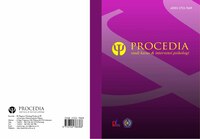Menurunkan kecemasan dengan Cognitive Behavior Therapy pada penderita Posttraumatic Stress Disorder
DOI:
https://doi.org/10.22219/procedia.v11i1.24047Abstract
Posttraumatic Stress Disorder is an anxiety disorder experienced after people see or live in a state of danger for more than one month. The assessment in this case used clinical interviews, observation, Wechsler Adult Intelligence Scale (WAIS), Sacks Sentence Completion Test (SSCT), graphics and wartegg, Thematic Apperception Test (TAT) and WHODAS 2.0. The intervention provided is Cognitive Behavior Therapy (CBT) which aims to change the subject's mindset to be more positive and adaptive behavior. The results of the intervention show that the percentage level of the subject's thoughts that she will die soon has been reduced to 30% and is aware that these thoughts are just mere shadows and do not necessarily occur to her, does not feel any physiological symptoms anymore since doing behavior activation in the second week, sleep quality begins to improve and have done new productive activities.
Keywords: PTSD, anxiety, cognitive behavior therapy
Abstrak
Posttraumatic Stress Disorder (PTSD) merupakan suatu gangguan yang muncul akibat individu mengalami suatu peristiwa yang memunculkan trauma yang berlangung lebih dari satu bulan. Tujuan dari studi kasus ini adalah untuk menurunkan PTSD. Metode asesmen yang digunakan untuk mendapatkan data dengan wawancara, observasi, Wechsler Adult Intelligence Scale, Sacks Sentence Completion Test, tes grafis dan wartegg, Thematic Apperception Test dan WHODAS 2.0. Intervensi yang diberikan kepada subjek adalah Cognitive Behavior Therapy. Hasilnya setelah dilakukan intervensi menunjukkan adanya perubahan tingkat pemikiran negative subjek, bahwa dirinya akan segera meninggal berkurang menjadi 30% dan memahami bahwa pikiran tersebut hanyalah distorsi dan belum tentu terjadi pada dirinya; tidak merasakan adanya gejala fisiologis lagi sejak melakukan behavior activation; kualitas tidur membaik dan dapat melakukan aktifitas yang produktif.
Kata kunci: PTSD, kecemasan, cognitive behavior therapy
Downloads
References
Abdullah, N. (2015). Hubungan Pola Asuh Orang Tua dengan Konsep Diri Anak Usia Sekolah. Seminar Psikologi & Kemanusiaaan, Psychologi Forum UMM, 2002, 978–979.
Afradipta, D. (2021). Restrukturisasi kognitif untuk mengurangi gejala kecemasan pada wanita yang mengalami premenopause. Procedia : Studi Kasus Dan Intervensi Psikologi, 9(1), 35–40. https://doi.org/10.22219/procedia.v9i1.15688
Allere. (2017). Discovering The Presence And Prevalence Of Post-Traumatic Stress Disorder Amongs The Victims Of Marawi Siege.
APA. (2013). Diagnostic And Statistical Manual Of Mental Disorders (DSM-5). American Psychiatric Publishing.
Berlina, Giyono, & Latif, S. (2013). Penggunaan Cognitive Behavior Therapy Teknik Relaksasi Untuk Menurukan Tingkat Kecemasan Berkomunikasi. Jurnal Bimbingan Konseling, 2(4), 1–13.
Clark, D. . (2013). Cognitive Restructuring. The Wiley Handbook of Cognitive Behavioral Therapy. https://doi.org/https://doi.org/10.1002/9781118528563.wbcbt02
Dwi Kurnia, R., & Hawadi, L. F. (2020). Gangguan neurotik remaja dan pola asuh orang tua: tinjauan Psikoanalisis sosial dan Islam dalam film dan novel posesif. MEIS-Jurnal Middle East and Islamic Studies, 7(2), 2020. https://doi.org/10.7454/meis.v7i2.126
Gepp, K. (2021). What is Behavioral Activation? https://www.medicalnewstoday.com/articles/behavioral-activation
Hatta, K. (2016). Trauma dan Pemulihannya suatu kajian berdasarkan kasus pasca konflik dan tsunami. In Dakwah Ar-Raniry Press.
Hurlock, E. . (1996). Psikologi perkembangan. Erlangga.
Iverach, L., Menzies, R. G., & Menzies, R. E. (2014). Death anxiety and its role in psychopathology: Reviewing the status of a transdiagnostic construct. Clinical Psychology Review, 34(7), 580–593. https://doi.org/10.1016/j.cpr.2014.09.002
J. Legg, T. (2019). 9 CBT Technique for Better Mental Health. https://www.healthline.com/health/cbt-techniques
Jannah, M., Kamsani, S. R., & Ariffin, N. M. (2021). Perkembangan Usia Dewasa : Tugas Dan Hambatan Pada Korban Konflik Pasca Damai. Jurnal Pendidikan Anak, 115–143. https://doi.org/http://dx.doi.org/10.22373/bunayya.v7i2.10430
Jayati, I. S., & Hadjam, M. N. R. (2015). Tata Laksana ‘ Behavioral Activation ’ untuk Menurunkan Tingkat Depresi pada Pasien Stroke. Gajah Mada Journal of Profesional Psychology, 1(2), 77–88. https://doi.org/https://doi.org/10.22146/gamajpp.9208
Kholisin, K. (2014). Kecemasan Berbicara Ditinjau Dari Konsep Diri Dan Kecerdasan Emosional. Jurnal Ilmu Dakwah, 34(1), 77. https://doi.org/10.21580/jid.v34i1.65
Koucky, E. M., Dickstein, B. D., & Chard, K. M. (2013). Cognitive behavioral treatments for posttraumatic stress disorder: empirical foundation and new directions. CNS Spectrums, 18(2), 73–81. https://doi.org/10.1017/S1092852912000995
Krisnanda, V. D., Ramli, M., & Hidayah, N. (2022). Konseling Cognitive Behavioral Therapy ( CBT ) untuk Mengembangkan Self-love Penyintas Trauma Kekerasan Dalam Rumah Tangga ( KDRT ). 11(November), 116–129. https://doi.org/10.25273/counsellia.v12i214167
Levers, L. L. (2012). Trauma counseling theories and interventions. Springer Publishing Company.
Pandya, A. K., & Kathuria, T. (2021). Death anxiety, religiosity and culture: Implications for therapeutic process and future research. Religions, 12(1), 1–13. https://doi.org/10.3390/rel12010061
Paramitha, R. G., & Kusristanti, C. (2018). Resiliensi Trauma dan Gejala Posttraumatic Stress Disorder (PTSD) pada Dewasa Muda yang Pernah Terpapar Kekerasan Trauma Resilience and Posttraumatic Stress Disorder ( PTSD ) Symptoms in Violence-Exposed Young Adults. Jurnal Psikogenesis, 6(2), 186–196. https://doi.org/https://doi.org/10.24854/jps.v6i2.701
Prabandari, D., Sukarja, I. M., & Maryati, N. L. . (2015). Pengaruh Cognitive Behavioral Therapy (CBT) Terhadap Post Traumatic Stress Disorder (Ptsd) Pada Pasien Post Kecelakaan Lalu Lintas Di Rsup Sanglah Denpasar. COPING NERS (Community of Publishing in Nursing), 3(2), 22–26.
Putri, A. F. (2018). Pentingnya Orang Dewasa Awal Menyelesaikan Tugas Perkembangannya. SCHOULID: Indonesian Journal of School Counseling, 3(2), 35. https://doi.org/10.23916/08430011
Rahmadian, A. A., Furqon, S. Y. L. N., & Rusmana, N. (2016). Prevalensi PTSD dan Karakteristik Gejala Stress. Edusentris, Jurnal Ilmu Pendidikan Dan Pengajaran, 3(1), 1–17. https://doi.org/https://doi.org/10.17509/edusentris.v3i1.184
Shubina, I. (2015). Cognitive-behavioral Therapy of Patients with PTSD: Literature Review. Procedia - Social and Behavioral Sciences, 165, 208–216. https://doi.org/10.1016/j.sbspro.2014.12.624
Sudirman, N. A. (2020). Cognitive therapy untuk mereduksi kecemasan pada dewasa. Procedia : Studi Kasus Dan Intervensi Psikologi, 6(2), 54–58. https://doi.org/10.22219/procedia.v6i2.12642
Teater, B. (2016). Cognitive Behavioural Therapy ( CBT ). ResearchGate, June, 1–10.
Zakiah, E. (2019). Behavioral Activation (BA) Untuk Menurunkan Gangguan Depresi Pada Mahasiswa Universitas Negeri Jakarta. 8, 100–104. https://doi.org/https://doi.org/10.21009/JPPP.082.07
Downloads
Published
How to Cite
Issue
Section
License
Copyright (c) 2023 Hanifa Timur Mawarizka, Siti Suminarti Fasikhah

This work is licensed under a Creative Commons Attribution-NonCommercial 4.0 International License.






